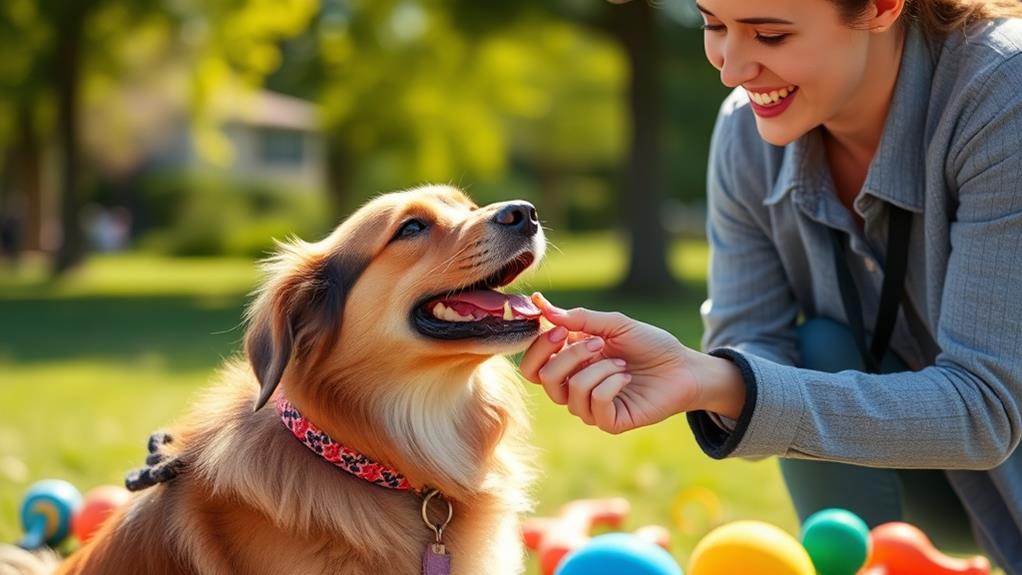Positive reinforcement training is an excellent way to teach your dog obedience and good manners. By rewarding desirable behaviors with treats, praise, or playtime, you create a positive association that motivates your dog to learn. This method strengthens the bond between you and your dog while reducing anxiety during training. Stay consistent with commands, deliver rewards immediately, and keep sessions short and fun. Don't forget to adjust your approach based on your dog's responses. With patience and persistence, you'll see progress in your dog's behavior. Keep exploring to uncover more techniques and tips for effective training!
Understanding Positive Reinforcement

Positive reinforcement is a powerful tool in training, helping you encourage desired behaviors in your dog. This approach focuses on rewarding your dog for good behavior instead of punishing them for mistakes. By doing so, you create a positive association with specific actions, making it more likely that your dog will repeat those behaviors in the future.
When you use positive reinforcement, you're not just offering treats; you're also providing praise, toys, or playtime. It's vital to deliver rewards immediately after the desired behavior occurs, so your dog makes the connection. Consistency is key, too. If you reward your dog for sitting one day but ignore it the next, they may become confused about what you expect.
Timing is imperative in positive reinforcement. By rewarding your dog right when they exhibit a good behavior, you help them understand what they did right. Remember, every dog is different, so be patient and observant. You might find that your dog responds better to certain types of rewards over others. Ultimately, understanding positive reinforcement helps you build a strong bond with your dog while encouraging good manners and obedience.
Benefits for Obedience Training

Obedience training using positive reinforcement offers numerous benefits that can enhance your relationship with your dog. By focusing on rewards rather than punishment, you create a supportive environment that fosters trust and cooperation.
Strengthened bond: Positive reinforcement helps build a strong connection between you and your dog, as they learn to associate your commands with rewards and praise.
Improved behavior: Consistent training leads to better manners, making it easier for your dog to navigate various environments and situations.
Increased motivation: Your dog will be more enthusiastic to learn and perform commands when they know a reward awaits them, making training sessions enjoyable.
Reduced anxiety: A positive approach minimizes fear and stress, allowing your dog to feel secure and confident during training.
Key Techniques for Success

How can you guarantee your positive reinforcement training is effective? Start by being consistent. Use the same commands and cues each time, so your dog knows exactly what you expect. Timing is pivotal; reward your dog immediately after they perform the desired behavior. This helps them make the connection between their actions and the reward.
Next, keep your rewards varied and exciting. Use treats, toys, or praise, depending on what motivates your dog most. If they start losing interest, switch it up to keep their enthusiasm high. Remember, the value of the reward should match the difficulty of the task. For challenging behaviors, offer higher-value treats.
Additionally, practice short, focused training sessions. Aim for 5-10 minutes, especially with young or easily distracted dogs. End each session on a positive note, rewarding them for any progress made, even if it's small.
Lastly, be patient and stay positive. If your dog doesn't understand right away, don't get frustrated. Instead, take a step back and simplify the command or behavior. Your calm demeanor encourages your dog to feel safe and willing to learn. With these techniques, you'll set the stage for successful training.
Common Behavior Challenges

Even with consistent training techniques, you may encounter common behavior challenges that can hinder your dog's progress. Recognizing these issues early on will help you tackle them effectively.
Here are some challenges you might face:
- Jumping on People: Your dog may greet guests with enthusiasm, but it can be overwhelming.
- Leash Pulling: Walks should be enjoyable, not a tug-of-war.
- Barking Excessively: This can disrupt your household and annoy neighbors.
- Chewing and Destructive Behavior: Dogs often chew on furniture or shoes out of boredom or anxiety.
Addressing these challenges takes patience and persistence. For instance, if your dog jumps, teach them to sit calmly when greeting others. If they pull on the leash, practice loose-leash walking techniques. For excessive barking, identify the trigger and work on desensitization. When it comes to chewing, provide appropriate toys and engage them in regular exercise to reduce boredom.
Building a Training Schedule

Creating a consistent training schedule is essential for achieving lasting results with your dog. Start by setting aside specific times during the week dedicated solely to training. This helps establish a routine that your dog can anticipate and look forward to. Aim for short sessions, around 5 to 15 minutes, to keep your dog engaged and prevent frustration.
Identify the best times for training based on your dog's energy levels. If your dog is more active in the morning, schedule training sessions then. Alternatively, if they tend to be more relaxed in the evening, adjust accordingly. Flexibility is key, so don't hesitate to adjust your schedule as needed.
Incorporate a variety of commands and behaviors into each session, focusing on one or two at a time. This allows your dog to master each skill before moving on. Remember to include regular practice throughout the day, reinforcing behaviors during walks or playtime.
Lastly, stay patient and positive. Celebrate small victories, and don't rush the process. With commitment and consistency, you'll see progress and a stronger bond with your furry friend.
Tools and Rewards to Use

Using the right tools and rewards can markedly enhance your positive reinforcement training sessions. Selecting effective rewards is essential because it helps motivate your dog and strengthens the bond you share. Here are some tools and rewards you might consider:
- High-Value Treats: Use small, tasty treats that your dog loves, especially during challenging training sessions.
- Clicker: This handy device allows you to mark desired behaviors instantly, making it clear to your dog what they did right.
- Toys: A favorite toy can serve as a reward, especially for dogs that thrive on playtime.
- Praise and Affection: Don't underestimate the power of your voice and gentle petting—many dogs respond well to positive verbal reinforcement.
Experiment with different combinations to see what resonates best with your dog. Remember, the goal is to create a positive and engaging atmosphere that encourages your dog to learn and obey. By using the right tools and rewards, you'll make your training sessions more enjoyable and effective for both you and your pet. Consistency is key, so keep at it, and you'll see great results!
Monitoring Progress and Adjustments

After establishing the right tools and rewards, it's important to keep track of your dog's progress throughout the training process. Monitoring your dog's behavior helps you identify what's working and where adjustments are needed. Start by setting clear, measurable goals for each training session. For example, if you're teaching "sit," aim for your dog to respond within a specific timeframe.
Keep a training journal to record your observations. Note the successes, challenges, and any patterns you see in your dog's responses. If you notice that your dog struggles with a particular command, don't hesitate to modify your approach. This might mean changing the reward, increasing the duration of training sessions, or breaking the command down into smaller steps.
Regularly review your goals and progress. Celebrate the small victories, but stay flexible. If a technique isn't yielding results, try a different method or introduce new rewards. Remember, training is a two-way street; your dog's progress depends on your consistency and adaptability. By monitoring closely and making necessary adjustments, you'll create a positive training experience that reinforces good behavior and strengthens your bond.
Frequently Asked Questions
Can Positive Reinforcement Work for All Dog Breeds?
Absolutely, positive reinforcement can work for all dog breeds. It taps into their natural instincts and motivates them to learn. By rewarding desired behaviors, you'll see improvements regardless of breed or temperament. Keep it consistent!
How Long Does It Take to See Results?
If you've ever trained a puppy, you know results can vary. Typically, you'll notice improvements within a few weeks, but consistency and patience are key. Every dog learns at their own pace, so stay committed!
What if My Dog Doesn't Respond to Rewards?
If your dog doesn't respond to rewards, it might be a sign that the rewards aren't motivating enough. Try different treats or activities, and guarantee you're timing the rewards correctly to reinforce desired behaviors effectively.
Can I Use Positive Reinforcement With Older Dogs?
You can use positive reinforcement with older dogs. They're capable of learning new tricks and behaviors too. Just be patient, adjust your approach, and watch how quickly they respond to your encouragement.
Is Group Training Effective for Obedience and Manners?
Group training can be highly effective for teaching obedience and manners. You'll find that socializing with other dogs and owners helps you reinforce commands, encourages consistency, and builds a supportive community for ongoing learning and improvement.
Conclusion
Incorporating positive reinforcement into your training routine doesn't just shape your dog's behavior; it strengthens your bond, too. As you celebrate each small victory together, you'll notice how these moments of connection make your dog more enthusiastic to learn. Just when you think you've hit a plateau, a breakthrough might surprise you, reminding you that patience and consistency pay off. Embrace the journey, and watch your furry friend thrive with newfound obedience and manners.



